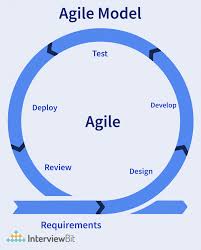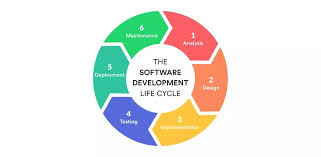The Agile Development Model: A Modern Approach to Software Development
In the world of software development, the Agile Development Model has gained significant popularity in recent years. This approach emphasizes flexibility, collaboration, and rapid iteration to deliver high-quality software products efficiently.
One of the key principles of the Agile Development Model is its iterative nature. Instead of following a linear development process, Agile teams work in short cycles called sprints. During each sprint, a small set of features or functionalities is developed, tested, and reviewed by stakeholders.
Another important aspect of Agile is its focus on collaboration. Cross-functional teams work closely together throughout the development process, ensuring that everyone is aligned on project goals and priorities. Regular communication and feedback loops are essential to the success of an Agile project.
One of the main benefits of the Agile Development Model is its ability to adapt to changing requirements and priorities. By breaking down projects into smaller increments and delivering working software at the end of each sprint, teams can quickly respond to feedback and make adjustments as needed.
Overall, the Agile Development Model offers a modern and efficient approach to software development that prioritizes collaboration, flexibility, and customer satisfaction. By embracing this methodology, organizations can deliver high-quality products more quickly and effectively than ever before.
Understanding Agile Development: Key FAQs and Insights
- What is Agile Development?
- What are the key principles of Agile?
- How does Agile differ from traditional software development methods?
- What are the benefits of using the Agile Development Model?
- What roles are involved in an Agile team?
- How do sprints work in Agile development?
- How does Agile handle changes in project requirements?
- What tools are commonly used in Agile development?
- How can organizations transition to an Agile approach?
What is Agile Development?
Agile Development is a modern software development methodology that emphasizes flexibility, collaboration, and iterative progress. In Agile Development, projects are broken down into smaller increments called sprints, allowing teams to deliver working software in short cycles. This approach promotes close collaboration among cross-functional teams and encourages constant communication and feedback. Agile Development enables teams to adapt to changing requirements quickly and efficiently, resulting in high-quality software products that meet customer needs effectively.
What are the key principles of Agile?
The key principles of Agile encompass flexibility, collaboration, iterative development, and customer satisfaction. Agile emphasizes the importance of adapting to change, working closely with cross-functional teams, delivering software incrementally in short cycles, and prioritizing customer needs and feedback throughout the development process. By adhering to these principles, Agile teams can respond quickly to evolving requirements, foster effective communication and teamwork, and ultimately deliver high-quality products that meet or exceed customer expectations.
How does Agile differ from traditional software development methods?
In the context of software development, Agile differs from traditional methods in several key ways. Unlike traditional approaches that follow a linear and sequential process, Agile is iterative and incremental, allowing for flexibility and adaptation to changing requirements. Agile emphasizes collaboration among cross-functional teams and encourages ongoing communication with stakeholders throughout the development process. Additionally, Agile focuses on delivering working software in short cycles, known as sprints, enabling quicker feedback and adjustments. This contrasts with traditional methods that often involve extensive planning upfront and longer development cycles before delivering a final product. Overall, Agile’s emphasis on adaptability, collaboration, and continuous improvement sets it apart from traditional software development methods.
What are the benefits of using the Agile Development Model?
The Agile Development Model offers a range of benefits that make it a popular choice for software development projects. One key advantage is its ability to adapt to changing requirements and priorities, allowing teams to deliver working software in short, iterative cycles. This approach promotes collaboration and transparency among team members, leading to faster feedback loops and improved communication. Agile also helps mitigate risks by breaking down projects into manageable increments and fostering a culture of continuous improvement. Overall, the Agile Development Model enables teams to deliver high-quality products more efficiently while maintaining flexibility and customer satisfaction throughout the development process.
What roles are involved in an Agile team?
In an Agile team, there are several key roles that play crucial parts in the development process. The roles typically include a Product Owner, who is responsible for defining and prioritizing the product backlog; a Scrum Master, who facilitates the Agile process and removes any obstacles that may hinder progress; and team members, who collaborate to deliver working software during each sprint. Additionally, stakeholders and customers may also be involved in providing feedback and guidance throughout the development cycle. Each role is essential in ensuring that the Agile team functions effectively and delivers high-quality products in a timely manner.
How do sprints work in Agile development?
In Agile development, sprints are time-boxed iterations during which a cross-functional team works collaboratively to deliver a set of features or functionalities. Typically lasting between one to four weeks, sprints begin with a planning session where the team selects tasks from the product backlog to work on. Throughout the sprint, team members work on their assigned tasks, holding daily stand-up meetings to discuss progress, challenges, and adjustments needed. At the end of the sprint, the team conducts a review meeting to demonstrate completed work to stakeholders and gather feedback. This iterative process allows for continuous improvement and adaptation based on stakeholder input, ensuring that the final product meets evolving requirements and expectations.
How does Agile handle changes in project requirements?
In the Agile Development Model, changes in project requirements are handled through its flexible and iterative approach. Agile teams welcome changes to requirements, viewing them as opportunities to improve the final product. By breaking down projects into short development cycles called sprints, Agile allows for frequent reassessment of priorities and adjustments to be made based on feedback. This adaptability ensures that the project remains aligned with evolving business needs and customer expectations throughout the development process. Regular communication and collaboration within cross-functional teams enable quick responses to changes, resulting in a more responsive and customer-centric approach to software development.
What tools are commonly used in Agile development?
In Agile development, various tools are commonly used to facilitate collaboration, communication, and project management within teams. Some of the popular tools include Jira, Trello, Asana, and Monday.com for project tracking and task management. Version control systems like Git are essential for managing code changes and ensuring team members are working on the latest version of the software. Communication tools such as Slack or Microsoft Teams help team members stay connected and exchange information efficiently. Continuous integration tools like Jenkins or Travis CI automate the process of building, testing, and deploying code changes. These tools play a crucial role in supporting Agile principles and practices by enabling teams to work together seamlessly and deliver high-quality software products effectively.
How can organizations transition to an Agile approach?
Transitioning to an Agile approach requires a cultural shift within organizations. It is essential for leadership to communicate the benefits of Agile development and foster a collaborative environment where teams can work together effectively. Training and coaching programs can help employees understand the principles of Agile and how to implement them in their daily work. Additionally, organizations should start by piloting Agile methodologies on smaller projects to gain experience and gradually scale up to larger initiatives. Embracing transparency, continuous feedback, and a willingness to adapt are key components of a successful transition to an Agile approach within organizations.



